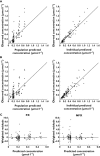Population PK modelling and simulation based on fluoxetine and norfluoxetine concentrations in milk: a milk concentration-based prediction model
- PMID: 24773313
- PMCID: PMC4239985
- DOI: 10.1111/bcp.12409
Population PK modelling and simulation based on fluoxetine and norfluoxetine concentrations in milk: a milk concentration-based prediction model
Abstract
Aims: Population pharmacokinetic (pop PK) modelling can be used for PK assessment of drugs in breast milk. However, complex mechanistic modelling of a parent and an active metabolite using both blood and milk samples is challenging. We aimed to develop a simple predictive pop PK model for milk concentration-time profiles of a parent and a metabolite, using data on fluoxetine (FX) and its active metabolite, norfluoxetine (NFX), in milk.
Methods: Using a previously published data set of drug concentrations in milk from 25 women treated with FX, a pop PK model predictive of milk concentration-time profiles of FX and NFX was developed. Simulation was performed with the model to generate FX and NFX concentration-time profiles in milk of 1000 mothers. This milk concentration-based pop PK model was compared with the previously validated plasma/milk concentration-based pop PK model of FX.
Results: Milk FX and NFX concentration-time profiles were described reasonably well by a one compartment model with a FX-to-NFX conversion coefficient. Median values of the simulated relative infant dose on a weight basis (sRID: weight-adjusted daily doses of FX and NFX through breastmilk to the infant, expressed as a fraction of therapeutic FX daily dose per body weight) were 0.028 for FX and 0.029 for NFX. The FX sRID estimates were consistent with those of the plasma/milk-based pop PK model.
Conclusions: A predictive pop PK model based on only milk concentrations can be developed for simultaneous estimation of milk concentration-time profiles of a parent (FX) and an active metabolite (NFX).
Keywords: breast milk; fluoxetine; modelling; population pharmacokinetics; simulation.
© 2014 The British Pharmacological Society.
Figures



 , present study;
, present study;  , median (2.8%);
, median (2.8%);  , 99th percentile (8.3%);
, 99th percentile (8.3%);  , Panchaud et al. . (B)
, Panchaud et al. . (B)  , median (2.9%);
, median (2.9%);  , 99th percentile (15.0%). (C)
, 99th percentile (15.0%). (C)  , median (5.9%);
, median (5.9%);  , 99th percentile (23.0%)
, 99th percentile (23.0%)Similar articles
-
Stereoselective pharmacokinetics of fluoxetine and norfluoxetine enantiomers in pregnant sheep.Drug Metab Dispos. 2004 Feb;32(2):212-21. doi: 10.1124/dmd.32.2.212. Drug Metab Dispos. 2004. PMID: 14744943
-
Prediction of infant drug exposure through breastfeeding: population PK modeling and simulation of fluoxetine exposure.Clin Pharmacol Ther. 2011 Jun;89(6):830-6. doi: 10.1038/clpt.2011.23. Epub 2011 Apr 27. Clin Pharmacol Ther. 2011. PMID: 21525869
-
Pharmacokinetics of fluoxetine and norfluoxetine in pregnancy and lactation.Clin Pharmacol Ther. 2003 Apr;73(4):330-7. doi: 10.1016/s0009-9236(02)17634-x. Clin Pharmacol Ther. 2003. PMID: 12709723 Clinical Trial.
-
The effects of renal and hepatic disease on the pharmacokinetics, renal tolerance, and risk-benefit profile of fluoxetine.Int Clin Psychopharmacol. 1993 Winter;8(4):261-6. doi: 10.1097/00004850-199300840-00009. Int Clin Psychopharmacol. 1993. PMID: 8277145 Review.
-
Pharmacokinetics, Placental and Breast Milk Transfer of Antiretroviral Drugs in Pregnant and Lactating Women Living with HIV.Curr Pharm Des. 2019;25(5):556-576. doi: 10.2174/1381612825666190320162507. Curr Pharm Des. 2019. PMID: 30894103 Review.
Cited by
-
Predicting Escitalopram Exposure to Breastfeeding Infants: Integrating Analytical and In Silico Techniques.Clin Pharmacokinet. 2018 Dec;57(12):1603-1611. doi: 10.1007/s40262-018-0657-2. Clin Pharmacokinet. 2018. PMID: 29651785
-
The value of midwifery counseling during lactation as a key factor of pharmacovigilance.Eur J Midwifery. 2022 Nov 24;6:65. doi: 10.18332/ejm/156439. eCollection 2022. Eur J Midwifery. 2022. PMID: 36474672 Free PMC article. No abstract available.
-
Population pharmacokinetic modelling of cetirizine concentrations in human breast milk-A contribution from the ConcePTION project.Basic Clin Pharmacol Toxicol. 2025 Jan;136(1):e14100. doi: 10.1111/bcpt.14100. Epub 2024 Nov 4. Basic Clin Pharmacol Toxicol. 2025. PMID: 39497323 Free PMC article.
-
Pharmacokinetics of Transfer of Azithromycin into the Breast Milk of African Mothers.Antimicrob Agents Chemother. 2015 Dec 28;60(3):1592-9. doi: 10.1128/AAC.02668-15. Antimicrob Agents Chemother. 2015. PMID: 26711756 Free PMC article. Clinical Trial.
-
Allopregnanolone Concentrations in Breast Milk and Plasma from Healthy Volunteers Receiving Brexanolone Injection, With Population Pharmacokinetic Modeling of Potential Relative Infant Dose.Clin Pharmacokinet. 2022 Sep;61(9):1307-1319. doi: 10.1007/s40262-022-01155-w. Epub 2022 Jul 23. Clin Pharmacokinet. 2022. PMID: 35869362 Free PMC article. Clinical Trial.
References
-
- Section of breastfeeding, American Society of Pediatrics. Breastfeeding and the use of human milk. Pediatrics. 2012;129:e827–841. - PubMed
-
- Cunningham AS, Jelliffe DB, Jelliffe EFP. Breast-feeding and health in the 1980s: a global epidemiologic review. J Pediatr. 1991;118:659–666. - PubMed
-
- Carpenter RG, Gardner A, Jepson M, Taylor EM, Salvin A, Sunderland R, Emery JL, Pursall E, Roe J. Prevention of unexpected infant death. Evaluation of thefirst seven years of the Sheffield Intervention Programme. Lancet. 1983;1:723–727. - PubMed
-
- Ruiz-Palacios GM, Calva JJ, Pickering LK, Lopez-Vidal Y, Volkow P Pezzarossi H, West MS. Protection of breast-fed infants against Campylobacter diarrhea by antibodies in human milk. J Pediatr. 1990;116:707–713. - PubMed
Publication types
MeSH terms
Substances
Grants and funding
LinkOut - more resources
Full Text Sources
Other Literature Sources

